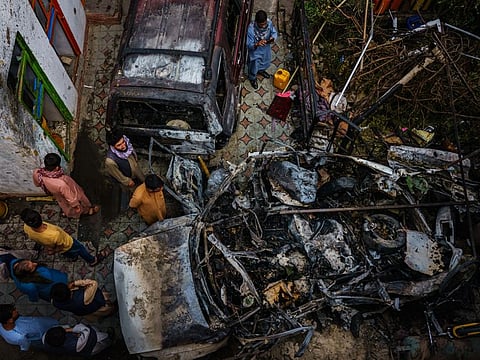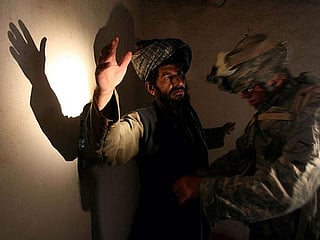Botched drone strike in Kabul started with wrong car
America killed 10 innocent civilians, including 7 children, with Hellfire missile

Washington: US military officials have insisted since the last American troops withdrew from Afghanistan last month that they would be able to detect and attack Daesh or Al Qaida threats in the country from afar.
But an errant drone strike that killed 10 civilians, including seven children, in Kabul on August 29 calls into question the reliability of the intelligence that will be used to conduct the operations.
US commanders concede that the missions will be more difficult without a military presence in the country. But new details about the drone strike, which the Pentagon initially said was necessary to prevent an attack on American troops, show the limitations of such counterterrorism missions even when US forces are on the ground.
“The US has a terrible record in this regard, and after decades of failed accountability, in the context of the end of the war in Afghanistan, the US should acknowledge that their processes have failed, and that vital reforms and more independent outside scrutiny is vital,” John Sifton, the Asia advocacy director at Human Rights Watch, said in an email.
Conflicting intel
Thirty-six hours before the strike, intelligence analysts and drone operators at a base in Qatar were sifting through more than 60 specific pieces of intelligence - some conflicting, some mutually reinforcing - related to an imminent attack by Daesh, according to Gen. Kenneth F. McKenzie Jr., the commander of the military’s Central Command.
The group, called the Over-the-Horizon Strike Cell, was created in early July to track and disrupt plots in Afghanistan by Al Qaida or the Daesh that threatened the US homeland. After the sudden Taliban takeover of the country, the cell began focusing on Daesh threats against the thousands of US troops at Hamid Karzai International Airport in Kabul who were helping tens of thousands of Afghans flee the country.
On the morning of August 29, the military was on high alert, looking out for a white Toyota Corolla as six Reaper drones monitored what McKenzie called a suspected Daesh compound, or safe house, both believed to be linked to the plot.
The strike cell commander kept in close contact with Maj. Gen. Christopher Donahue, the head of the 82nd Airborne Division and the ground force commander at the airport. McKenzie was also kept apprised of the developments during the day.
Longtime worker for a US aid group
Just before 9am, Zemari Ahmadi, a longtime worker for a US aid group, wheeled his white 1996 Toyota Corolla in front of the safe house the Americans were watching. Two men got out of the car, met with another man at the safe house, took a bag from him and returned to the car. Ahmadi drove off.
Eight hours later, a Hellfire missile slammed into the sedan, killing Ahmadi and nine other people in what US officials now acknowledge was a tragic case of mistaken identity.
“Clearly our intelligence was wrong on this particular white Toyota Corolla,” McKenzie told reporters Friday. “We thought this was a good lead. We were wrong.”
Military officials have declined to release the strike cell commander’s name, rank or organisation, but say he is an experienced operator who has carried out drone strikes in multiple theatres.
140 people killed
The strike against a white Toyota believed to be carrying explosives was launched, McKenzie said, “in the profound belief” that ISIS-K, was about to attack the airport, as the terrorist group had done three days earlier, killing more than 140 people, including 13 US service members.
“This was not a rushed strike,” the general said. “The strike cell deliberately followed and observed this vehicle and its occupants for eight hours while cross-checking what they were seeing with all available intelligence to develop a reasonable certainty of the imminent threat that this vehicle posed to our forces.”
In his Pentagon news conference, McKenzie sought to explain the context in which the drone strike commander and his team made their decision, ultimately with the approval of Donahue, the ground commander and one of the most storied operators of his generation with 17 deployments to Afghanistan, Iraq, Syria and North Africa in a nearly 30-year career.
Surveillance
Two days before the drone strike, the military determined through electronic intercepts, informants and aerial surveillance that Daesh planners were using a compound about 5km northwest of the airport to facilitate future attacks with rockets, suicide explosive vests and car bombs.
One recurring aspect of the intelligence, McKenzie said, was that Daesh would use a white Toyota Corolla as a key element in the next attack against US troops at the airport.
After the suspected Daesh safe house emerged as the strongest lead in the feared attacks, the military assigned as many as six MQ-9 Reaper drones to monitor it on the morning of Aug. 29.
At 8.52am, a white Toyota Corolla - Ahmadi’s sedan - arrived at the compound, the military said, and the package exchange occurred.
But witness testimony and visual evidence gathered by The New York Times indicate that this compound was most likely the home of Ahmadi’s boss, the country director of Nutrition and Education International, a California-based aid group.
The director had asked Ahmadi to stop by his home to pick up his laptop on the way to work that morning. The director has denied any ties to the Daesh. A senior US military official said analysts are now exploring the possibility that the safe house was actually a neighbouring house.
From that point on, however, Ahmadi’s sedan became the military’s primary suspect in the plot.
Unloading jugs
Military analysts seized on other movements by Ahmadi as he drove around Kabul to reinforce their judgment. At 11.19am, at least two men unloaded jugs from the trunk of the sedan at another compound, which the military now says was the aid organisation’s headquarters. But at the time, commanders did not know that. They received intelligence reports at the time that an Daesh cell leader in Kabul was dropping off supplies.
After other errands, the Toyota Corolla returned to the aid organisation’s headquarters and analysts observed men loading into the trunk what the Americans believed were explosives before the sedan left at 3.47pm. The military’s investigation later determined the packages were probably water canisters.
It was just before 5pm when the white sedan made its final stop - in a courtyard off a busy street about 3km from the airport. McKenzie said the “cumulative force” of the information the military had collected throughout the day - the vehicle’s earlier stop at the suspected Daesh compound, the loading into the car of what analysts believed were explosives and the proximity of the car to the airport - was damning.
“To the strike cell, this all added up,” he said.
Killer strike
At this point, the strike cell commander controlling the armed Reaper drones had to make a quick decision. His authority to strike had been delegated by McKenzie several days earlier.
The rules of engagement allowed the military to conduct a strike if the operators and intelligence analysts had “reasonable certainty” that they had a legitimate Daesh target and assessed there was a “reasonable certainty” that no noncombatant civilians, including women and children, would be killed or injured. McKenzie said the commander believed that standard was met, and the general said he agreed at the time with that judgment.
The drone operators took a few minutes to scan the close confines of the courtyard and saw only the one other man talking to the driver. The commander and his team concluded this was the best time and place to take the shot. If the Americans waited and the vehicle wove through busy city traffic or approached the airport, the risk to civilians would be much greater - either from a drone strike or the detonation of suicide vests or a huge car bomb.
Most likely children
Donahue, the ground force commander, concurred after asking several questions to validate the attack, a Defence Department official said, and the Hellfire missile struck its target in less than a minute. Seconds after the missile was launched, the drone operators could see on the grainy live-video feed that other figures - most likely children - were approaching the sedan. But it was too late to stop the strike.
“It was a mistake, and I offer my sincere apology,” McKenzie said Friday.
He said future American airstrikes in Afghanistan would be different from the one taken August 29. They would be what the military calls deliberate strikes, which he said would be subject to more stringent rules of engagement with more time to monitor a potential target, plan an attack and assess the risk to civilians, a process the military calls establishing “a pattern of life.”
“We did not have the luxury of time to develop pattern of life and to do a number of other things,” McKenzie said of the August 29 missile attack. “I don’t think you should draw any conclusions about our ability to strike in Afghanistan against ISIS-K targets in the future based on this particular strike.”
But other military experts are calling for an overhaul of the procedures the military uses to identify targets and carry out drone strikes.
“You never want to judge too much from a single incident, but the way they bungled fundamental operational things is really troubling and suggests more than a one-off mistake,” Luke Hartig, who worked on drone strike policy for the Obama administration as a senior director for counterterrorism at the National Security Council, said in a Twitter post Friday.
“Its interpretation of an innocent man’s set of movements as those of a terrorist or an attack facilitator show some massive flaws in targeting methodology,” Hartig said.
Who should be held accountable?
Defence Secretary Lloyd Austin has ordered a review of the Central Command’s inquiry into the drone strike to determine, among other issues, who should be held accountable and “the degree to which strike authorities, procedures and processes need to be altered in the future.”
On Monday, John F. Kirby, the chief Pentagon spokesperson, said that Austin had directed the Air Force to select a senior general to conduct the review, to be completed within 45 days. The Air Force said Tuesday that it had assigned Lt. Gen. Sami D. Said, the Air Force inspector general, to the task. An experienced F-15 and F-16 fighter pilot, Said served as a senior staff officer in Afghanistan in 2013 and 2014.
In the meantime, Austin, a retired four-star Army general, has ordered that any further airstrikes in Afghanistan receive his approval.
Sign up for the Daily Briefing
Get the latest news and updates straight to your inbox






![Facility temporarily closed as authorities probe safety lapses. [Illustrative image]](http://media.assettype.com/gulfnews%2F2025-12-19%2Fgzzcwfvh%2FSauna.jpg?w=320&auto=format%2Ccompress&fit=max)


